
Annual Bulletin 6, 1982-1983
Home
Français
Introduction
History
Annual Index
Author &
Subject
Credits
Contact
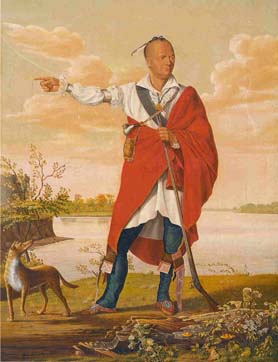
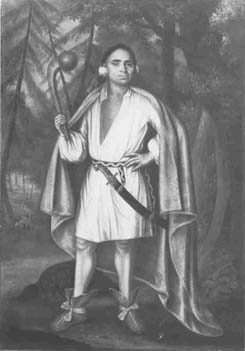
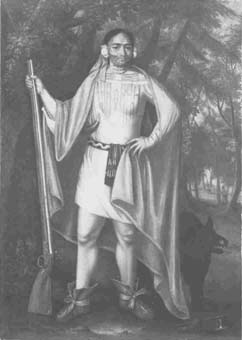
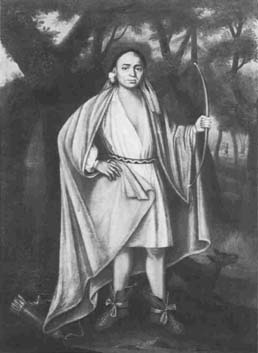
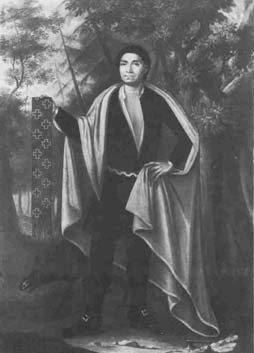
William Berczy's Portraits of Joseph Brant
by Gloria Lesser*
Article en français
Pages 1 | 2
| 3 | 4
| 5 | 6
| 7 | 8
*This article has been adapted from a Master's Thesis, which was originally prepared
and presented to the Department of Art History at Concordia University,
Montreal, in March 1983. I would like to thank François-Marc Gagnon,
Conrad Graham, Sandra Paikowsky, and Laurier Lacroix, who helped me in
my initial research.
Joseph Brant (1742-1807) was renowned as a celebrated Mohawk chief, Loyalist
Indian
statesman, and warrior. His portrait was painted on numerous occasions,
especially during the period 1776-1807. These portraits, which include paintings, miniatures, drawings, and engravings, were done by leading
portraitists in England, such as George Romney, the United States, such
as Gilbert Stuart, Charles Willson Peale, and Ezra Ames, and by a German
artist who emigrated to the British colony of Upper Canada, William Berczy. (1) Joseph Brant's image has continued to be accessible, circulated through
prints or copies, until today. This article will concentrate on the portraits
of Joseph Brant by William Berczy (1749-1813).
The portraits of Joseph Brant have a precedent in the renderings of Indians that were produced in the sixteenth and
seventeenth centuries, an era which I have classified as the 'pre-contact'
period, when the first Europeans visited the New World. Visitors to America
were navigators, soldiers, cartographers, explorers, draughtsmen and
clerics who were adventurers, not artists. They made maps, mainly outlines
of coasts, or the site or plan of a fort. Depictions of Indians were sometimes
included in their maps when they attempted to delineate Indian territory.
They recorded the Indians in terms of their own European prejudices based
on the contemporary notions current in philosophy and religion.
By the eighteenth century, artists attempting to grasp concepts of Indian culture generally viewed
Indians as curious and exotic
figures within an extraordinary society. During the second half of the
eighteenth century, European artists, according to the prevailing theories
of the Enlightenment with its doctrine of Reason and Nature, began to look
for the formal principles underlying art. Although John Dryden used the
term "noble savage" as early as 1670 in The Conquest of Granada, the
concept has come to be associated primarily with France, where it was popularized
by Rousseau's writings. The eighteenth-century political philosopher Jean-Jacques
Rousseau's idea of the natural man unspoiled by civilization was a romantic notion which soon extended to the American
Indian being regarded as
the "noble savage." (2)
To European artists of the eighteenth century, these ideas
sometimes manifested themselves as a decorative mannerism in the style
known as Rococo, a style applied to the figure painting of Europeans
as well as Indians. One manifestation of this mental imagery was the "imaginary"
Indian who became prevalent as a symbol of the continents of the Americas,
and who metaphorically represented the exotic parts of the world.
Imaginary Indians of this genre were treated in a naturalistic style portrayed full-length
in an undefined pastoral landscape, adopting a casual, but artificially
conventional pose as in aristocratic portraiture. This kind of Indian usually
enriched decorative objects such as a Boule clock, Sèvres or Meissen
porcelain, Gobelins tapestry, toile de Jouy chinoiserie, wallpaper murals,
or woodblocked cottons. (3)
Even though the dominant art form practiced in the thirteen
colonies before the American Revolution was portraiture, only a few portraits
of individual Indians were produced between 1675-1775. "To painters dependent
for their livelihood upon commissioned portraits, the Indian, like all
the lower classes, was beyond the range of patronage." (4) The few paintings
of individual Indians done during the eighteenth century usually represent
a small group of chieftains who took part in historic events, such as the
Four Indian Kings discussed below. Interest in the chief of a tribe denotes
the hierarchical European classification of peoples in terms of class
and rank followed at the time. Dealing with the Indian reality by imposing
a social classification is a bias which does not fit with Indian culture,
especially since authority is not designated in Indian culture as a permanent
function. (5)
In 1710, four Indian chiefs, Etow Oh Koam (fig. 1) , Sa
Ga Yeath Qua Pieth Tow (Joseph Brant's grandfather) (fig. 2), Ho Nee Yeath
Taw No Ro (fig. 3), and Tee Yee Neen Ho Ga Ro (fig. 4), were taken to London
to publicize the need for a stronger defence of the thirteen colonies against
the French. During their celebrated visit they were received by Queen Anne,
who commissioned John Verelst (1648?-1734) to execute their portraits.
The formal detail, attitude, pose and costume - conventions seen in Verelst's
portraits of the Four Indian Kings (1710, Public Archives of Canada,
Picture Division) - had appeared as early as 1564 in the watercolours of
decorative Indians made by France's Jacques le Moyne de Morgues (d. 1588) (6),
and also in the engravings of Brazilian Indian chiefs made in 1584 by the
Franciscan traveller and French court historiographer-cartographer, André
Thévet (1502-1590), who had stayed a few months in Brazil and who
published traveller's reports on his return. (7)
The archetypal 'noble savage / natural man' pre-contact
definition of Indians gradually extended to and incorporated artifacts
of contact, such as the European clothing and weapons which were adopted
increasingly by Indians from the beginning of the eighteenth century. The combination of Indian and English artifacts indicates current Indian
acculturation and serves as a testimonial of European contact in portraits
such as the Four Indian Kings. The elements of destruction which
would eventually lead to the demise of Indian culture can be documented.
The shotflask and carrying sash, as well as the flintlock rifle of the
British military, c. 1710, are proudly borne, contemporary in style, and
acquired through trade. In these portraits, the trade objects shown are
the weapons and plain scarlet cloak which Queen Anne had presented each
Indian chief for the sitting. Presentation silver was actively traded only
between about 1760-1821. (8)
Next Page | commissioned
portraits
1 | 2 | 3
| 4 | 5
| 6 | 7
| 8
Annual Index | Author & Subject | Credits | Contact
This digital collection
was produced under contract to Canada's Digital Collections program,
Industry Canada.
"Digital
Collections Program, Copyright
© National Gallery of
Canada 2001"